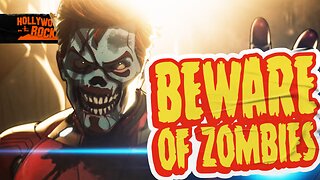Premium Only Content

Workers Wanted!
Rumble = https://rumble.com/user/SweetHomeStAugustine
Locals = https://sweethomesa.locals.com/
POPULIST REVOLT = https://populistrevolt.com
https://www.theepochtimes.com/gen-z-says-no-to-work-yes-to-debt_4457565.html?utm_source=uschinanoe&utm_campaign=uschina-2022-05-18&utm_medium=email&est=iOrvultax%2FSbTugPsIzPzol%2FTfUvbP%2F%2FbeOvPDUaCfAgy4bCFpUqISV837%2FTVqKl
Gen Zers are leaving the workplace in high numbers. At the very same time, they are falling deeper into debt.
You’re undoubtedly familiar with “buy now, pay later” (BNPL), a type of short-term financing that allows a consumer to purchase something immediately and pay for it later. The BNPL model has soared in popularity in recent years, and 39 percent of Americans have tried BNPL at least once.
In 2020, according to the California Department of Financial Protection (DFPI), 91 percent of consumer loans issued by the state were BNPL loans.
The financial flexibility offered is indeed appealing—perhaps a little too appealing. In the United States, members of Generation Z, also known as the TikTok generation, are the biggest users of BNPL services. This should come as little surprise. BNPL came of age when online shopping was just gaining steam; no generation is as active online as Gen Z. These digital natives spend an average of 2 hours and 43 minutes online every single day; that works out at more than three full days per month. That’s a lot of browsing and swiping.
Of all the social media platforms, TikTok is the most popular among Gen Zers (hence the TikTok generation moniker). For Gen Z, Instagram is losing its appeal. TikTok, on the other hand, is growing in popularity. In the United States alone, it boasts 80 million monthly users, 60 percent of whom are female.
Worryingly, though, many influencers on TikTok are pushing the BNPL narrative. Because of this, millions of Gen Zers are purchasing things they don’t need; worse still, they’re racking up enormous amounts of debt in the process.
In a recent article for SFGATE, the writer Joshua Bote discussed the myriad ways in which “Gen Z, in particular, has fallen in love with short-term loans.” This is problematic on many levels, he argued, especially when one couples “nearly instantaneous loans with an influencer-addled social media culture that prioritizes exorbitant spending and normalizes debt.”
Indeed. Right now, you’re just a few clicks away from being able to purchase an item or service that you probably don’t need.
Affirm, one of the leaders in the BNPL market recently signed a lucrative contract with Amazon. The reason why Amazon signed the deal is relatively simple: BNPL encourages people to spend more. In the United States, 60 percent of Gen Zers have an Amazon Prime account. In 2019, Amazon overtook Apple as Gen Z’s favorite brand. Perhaps this helps explain why this particular generation is spending more than other generations—a lot more.
According to the aforementioned Bote, Gen Zers are currently “spending 925% more” today than at the same point in 2020.
Numerous articles have been written about Gen Z’s good money habits; they scrupulously save, we’re told. In truth, though, the average Gen Zer is drowning in debt. In fact, they have the highest total average debt by generation.
While members of Gen Z continue “revenge spending” (a phenomenon that sees consumers rush to make up for all the purchases they couldn’t make during the COVID-19 lockdown), they would do well to ask themselves, who exactly am I getting revenge on? Spoiler alert: The answer is no one but yourself.
The rise of BNPL and “revenge spending” comes simultaneously as Gen Z is busy disrupting the workplace. Fifty-six percent of Gen Zers would rather be unemployed than let a job interfere with their personal lives. This generation has dreams, big dreams—just not dreams of working. This is the generation that inspired last year’s quitting spree.
How is one expected to actually pay for goods and services without a source of income? This might sound like an obvious question to ask. Nevertheless, sometimes the obvious needs to be asked.
Although millennials, my own generation, are not exactly a shining example, Gen Zers appear to be even less resilient. A frightening thought, I know. After all, what is more fragile than a snowflake? A lack of resilience is closely associated with poorer mental health; a less resilient person is more likely to struggle with depression and anxiety. Not surprisingly, members of Gen Z are struggling with both.
To conclude, being in debt is the stuff of nightmares; it leads to sleepless nights and endless anxiety. So before you avail of an “instant loan,” ask yourself these three questions: Is it worth it? Do I need it? Do I have the means to pay back what is owed? If the answer to any of these questions is no, then don’t, under any circumstances, avail of the loan.
-
 LIVE
LIVE
Kim Iversen
1 hour agoEPSTEIN VICTIM: We Have The Names. We'll Make The List.
2,593 watching -

Redacted News
1 hour agoBREAKING! Putin's DEVASTATING news for Europe | Secret UFO Space Base in Huntsville | Redacted Live
13.2K43 -
 1:17:49
1:17:49
vivafrei
4 hours agoEpstein Press Conference DEBACLE! Missing Minute FOUND? Canada Continues to Fall! & MORE!
63.6K43 -
 29:30
29:30
Stephen Gardner
1 hour ago🟢YES! Trump’s Doing It! Ben Shapiro UNLEASHES on Democrat STUPIDITY!
4.78K9 -
 LIVE
LIVE
Dr Disrespect
6 hours ago🔴LIVE - DR DISRESPECT - METAL EDEN - NEW 2025 SCI-FI FPS LAUNCH STREAM
1,136 watching -
 LIVE
LIVE
StoneMountain64
4 hours agoBattlefield's Easter Egg Phantom Project is STILL ALIVE
146 watching -
 LIVE
LIVE
LFA TV
10 hours agoLFA TV ALL DAY STREAM - WEDNESDAY 9/3/25
1,511 watching -
 LIVE
LIVE
freecastle
6 hours agoTAKE UP YOUR CROSS- Love...Light...TRUTH!
167 watching -
 1:50:29
1:50:29
The Quartering
3 hours agoEpstein Victims To NAME People, Mutiny Over RFK Jr, Trump Turns On Warp Speed?
120K42 -
 LIVE
LIVE
Film Threat
21 hours agoMARVEL ZOMBIES! PLUS DEXTER RESURRECTION | Hollywood on the Rocks
80 watching